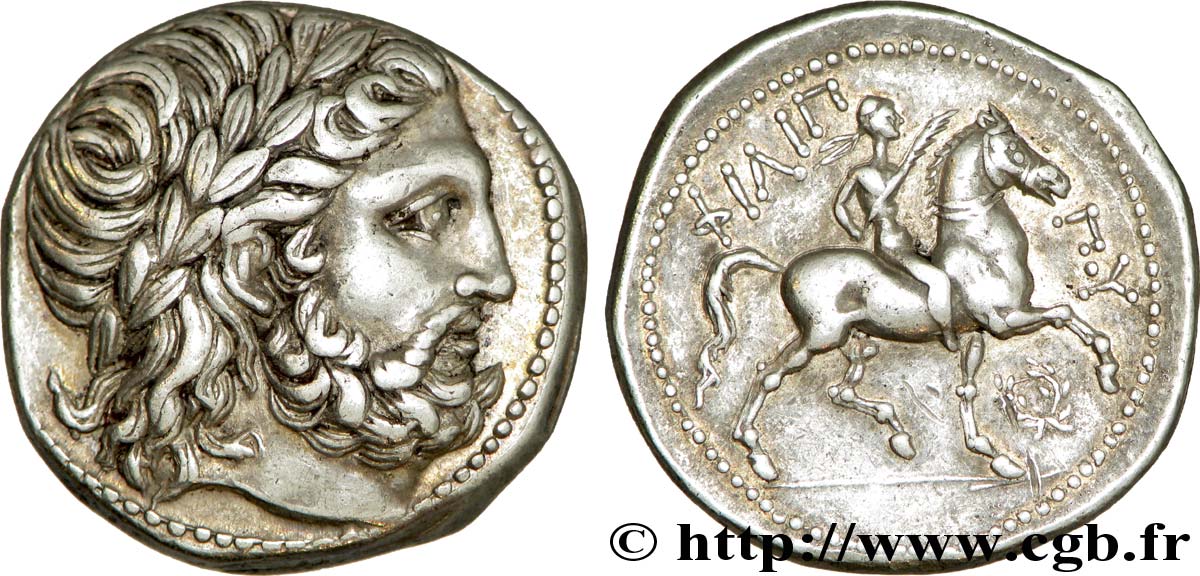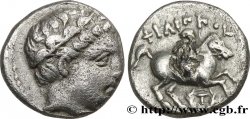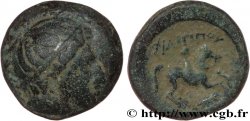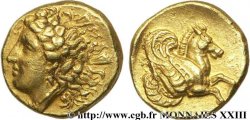v32_0023 - MACEDONIA - REGNO DI MACEDONIA - FILIPPO III ARRIDAIOS Tétradrachme
MONNAIES 32 (2007)
Prezzo di inizio : 950.00 €
Valutazione : 1 500.00 €
Prezzo realizzato : 1 120.00 €
Numero di offerte : 2
Offerta maxima : 1 200.00 €
Prezzo di inizio : 950.00 €
Valutazione : 1 500.00 €
Prezzo realizzato : 1 120.00 €
Numero di offerte : 2
Offerta maxima : 1 200.00 €
Tipo : Tétradrachme
Data: 323/322-316/315 AC
Nome della officina / città: Macédoine, Pella
Metallo : argento
Diametro : 24,5 mm
Asse di coniazione : 6 h.
Peso : 14,24 g.
Grado di rarità : R1
Commenti sullo stato di conservazione:
Exemplaire de qualité exceptionnelle pour ce type sur un flan parfaitement centré des deux côtés. Portrait de toute beauté. Revers avec le grènetis visible. Pas d’usure au revers, mais style un peu pauvre. Magnifique patine de médaillier avec des reflets mordorés
N° nelle opere di riferimento :
Pedigree :
Cet exemplaire provient de la vente Lanz 125, 28 novembre 2005, n° 227
Diritto
Titolatura diritto : ANÉPIGRAPHE.
Descrittivo diritto : Tête laurée de Zeus à droite.
Rovescio
Descrittivo rovescio : Cavalier au pas à droite, tenant une palme de la main droite ; le cheval lève l'antérieur à droite ; sous le cheval, entre les antérieurs, une couronne fermée.
Legenda rovescio : FILIP-POU
Commento
Nouveau groupe pour l’atelier de Pella avec la couronne entre les antérieurs du cheval. Ce symbole relativement rare a été utilisé par l’atelier de Pella sous le règne d’Alexandre III (Le Rider, p. 51, n° 384-387, pl. 16) et à Amphipolis sous Philippe III associé à différentes lettres (Le Rider, pl. 45/22 à 45/28). Même coin de droit que l’exemplaire de la collection Löbbecke conservé à Berlin, n° 519, pl. 22 (A/ 277) associé au foudre et qui ne semblait pas associé à d’autres tétradrachmes. Le coin de revers est donc complètement nouveau et semble pouvoir être attribué à Philippe III en raison de la liaison de coin de droit intergroupe (foudre et couronne). Le revers est légèrement stylisé, le cheval grêle, le cavalier mince avec de grands rubans à la couronne, une palme mince et schématique. Les lettres sont toutes bouletées et l’omicron est figuré sous la forme d’un point.
New group for the Pella mint with the crown between the horse's forelegs. This relatively rare symbol was used by the Pella mint during the reign of Alexander III (The Rider, p. 51, no. 384-387, pl. 16) and at Amphipolis under Philip III associated with different letters (The Rider, pl. 45/22 to 45/28). Same obverse die as the copy from the Löbbecke collection in Berlin, no. 519, pl. 22 (A/ 277) associated with the thunderbolt and which did not seem to be associated with other tetradrachms. The reverse die is therefore completely new and seems to be attributable to Philip III because of the intergroup obverse die connection (thunderbolt and crown). The reverse is slightly stylized, the horse slender, the rider slim with large ribbons to the crown, a thin and schematic palm. The letters are all rounded and the omicron is represented in the form of a point
New group for the Pella mint with the crown between the horse's forelegs. This relatively rare symbol was used by the Pella mint during the reign of Alexander III (The Rider, p. 51, no. 384-387, pl. 16) and at Amphipolis under Philip III associated with different letters (The Rider, pl. 45/22 to 45/28). Same obverse die as the copy from the Löbbecke collection in Berlin, no. 519, pl. 22 (A/ 277) associated with the thunderbolt and which did not seem to be associated with other tetradrachms. The reverse die is therefore completely new and seems to be attributable to Philip III because of the intergroup obverse die connection (thunderbolt and crown). The reverse is slightly stylized, the horse slender, the rider slim with large ribbons to the crown, a thin and schematic palm. The letters are all rounded and the omicron is represented in the form of a point








 Segnalare un errore
Segnalare un errore Stampate la pagina
Stampate la pagina Condividi mia selezione
Condividi mia selezione Fai una domanda
Fai una domanda Consegnare / vendere
Consegnare / vendere
 Descrittivo
Descrittivo













